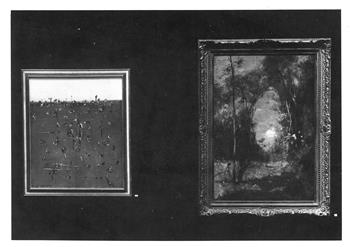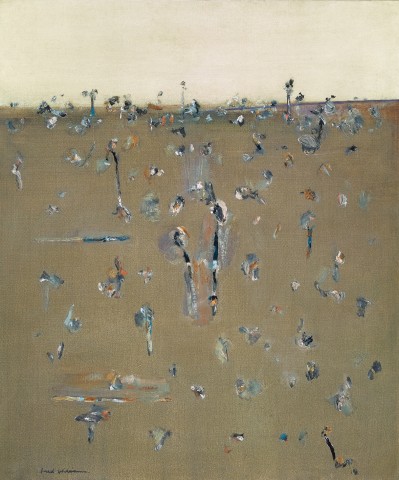UPWEY, 1965
FRED WILLIAMS
oil on canvas
86.0 x 70.5 cm
signed lower left: Fred Williams
bears inscription on backing verso: 1050
The Estate of Fred Williams, Melbourne
Lyn Williams, Melbourne
Nevill Keating Pictures, London
Private collection, London
Private collection, Sydney
Heroic Landscape: Williams/Streeton, National Gallery of Victoria, Melbourne, 16 October – 22 November 1970, cat. 38 (label attached verso)
Visions of Australia 1950 – 2000, Nevill Keating Pictures, London, 6 – 28 July 2000, cat. 3 (illus. cover of exhibition catalogue)
McCaughey, P., Fred Williams, Bay Books, Sydney, 1987, p. 211 (illus. as ‘Upwey Landscape’)
Five years after Upwey, 1965 was painted it was included in a confident and prescient exhibition at the National Gallery of Victoria pairing the work of Fred Williams and Arthur Streeton. Williams was 43, Streeton died in 1943 and was last exhibited in a memorial exhibition at the National Gallery of Victoria in 1944. Williams admired the Heidelberg School painters and owned a 9 by 5 panel.1 The exhibition’s curator, Brian Finemore, wrote, ‘As the European settlement of Australia progressed … the visual arts moved from description of a topographical kind to an interpretation of the artists’ personal involvement with this land … taking the landscape as “hero” in their art, each has changed radically and enlarged our awareness of our environment.’2 Upwey represents the peak of Fred Williams at his most distinctive and masterful. In 1962 he and his wife, Lyn, moved to Upwey – Streeton retired to Olinda in 1938, a fifteen-minute drive north.
The 1960s was a decade where Williams’ images became important in defining a unique and original Australianness and the vision of our landscape. The works immediately preceding the Upwey paintings reveal more formal and descriptive elements, were usually painted on board and built up through subtle and richly half-tone glazed surfaces. Important works from this period (1957-1963) are represented in major public collections. But by the mid-sixties, Williams had all but worked through this particular formalism and paintings, watercolours, drawings and etchings of infinite subtly and variation mark a prolific new energy.3
dh200639_FRED WILLIAMS, Upwey Landscape, 1965 NGV install.jpg

Works with single demarcated elements such as a high horizon line reoccur. Skies are an infinite space and the landscape below is vast and contained within the artist’s imagination and his deft, painterly control. The surface becomes an expanse for Williams’ distinctive minimal forms and flecked intonations, where the immediacy of painting never allows for any gesture to be repeated. All the while they suggest the unpatterned irregularity of something observed and formed into an astonishing work of art in the studio.
While the National Gallery of Victoria’s exhibition might now be viewed as connecting two generations of great landscapists, there are other aspects which Williams and Streeton shared. Both were brilliant painters in using half-tones and neither was timid using black to describe and delineate forms. Similarly, Streeton works from the 1890s often pushed the horizon line to the top of the picture plane. In his Sirius Cove, c.1895 the wood panel is vertical and narrow with rocks in various forms descending to the foreground.4 Upwey relates to other major works with a high horizon line and expressive gestures arranged below it – a considered spontaneity with the landscape as its wellspring.5
1. Charles Conder, Impressionists’ camp, 1889, oil on paper on cardboard, 13.9 x 24.0 cm, National Gallery of Australia, Canberra, Gift of Mr and Mrs Fred Williams and family, 1979
2. Finemore, B., ‘Introduction’, Heroic Landscape: Williams / Streeton, National Gallery of Victoria, Melbourne, 1970
3. Hummock in Landscape, 1967, oil on canvas, 152.5 x 122 cm. Deutscher and Hackett, Melbourne, 15 July, 2020. lot 7. The essay accompanying this work complements the principal stylistic and technical aspects of Upwey, 1965.
4. Arthur Streeton, Sirius Cove, c.1895, oil on wood panel, National Gallery of Australia, purchased 1973
5. Upwey Landscape, 1965, oil on canvas, National Gallery of Victoria, Felton Bequest, 1965. This work was included in Heroic Landscape: Williams / Streeton, catalogue no. 39. The exhibition’s curator, Brian Finemore, later discussed it in Freedom from Prejudice: An introduction to the Australian Collection in the National Gallery of Victoria, National Gallery of Victoria, Melbourne, 1977.
DOUG HALL, AM
